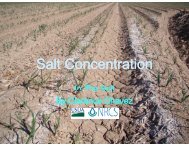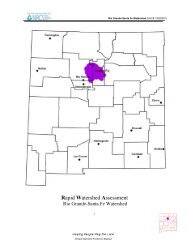SAMPLING VEGETATION ATTRIBUTES - New Mexico NRCS - US ...
SAMPLING VEGETATION ATTRIBUTES - New Mexico NRCS - US ...
SAMPLING VEGETATION ATTRIBUTES - New Mexico NRCS - US ...
You also want an ePaper? Increase the reach of your titles
YUMPU automatically turns print PDFs into web optimized ePapers that Google loves.
134<br />
GLOSSARY<br />
grazable woodland: forestland on which the understory includes, as an integral part of the<br />
forest plant community, plants that can be grazed without detrimental impact to other<br />
forest values.<br />
ground cover: The percentage of material, other than bare ground covering the land surface.<br />
It may include live and standing dead vegetation, litter cobble, gravel, stones, and<br />
bedrock. Ground cover plus bare ground would total 100 percent.<br />
half shrub: a plant with a woody base whose annually produced stems die each year.<br />
H<br />
herbaceous: vegetation growth with little or no woody component; nonwoody vegetation<br />
such as graminoids and forbs.<br />
hedging: (1) the appearance of browse plants that have been browsed so as to appear<br />
artificially clipped; or (2) consistent browsing of terminal buds of browse species that<br />
results in excessive lateral branching and a reduction in upward and outward growth.<br />
herbage: the above-ground material of any herbaceous plant (grasses and forbs).<br />
interpretation: explaining or telling the meaning of something and presenting it in understandable<br />
terms.<br />
I<br />
inventory: the systematic acquisition and analysis of information needed to describe, characterize,<br />
or quantify resources for land-use planning and management of the public lands.<br />
K<br />
key area: a relatively small portion of a range selected because of its location, use or grazing<br />
value as a monitoring point for grazing use. It is assumed that key areas, if properly<br />
selected, will reflect the overall acceptability of current grazing management over the<br />
range.<br />
key species: (1) forage species whose use serves as an indicator to the degree of use of<br />
associated species. (2) those species which must, because of their importance, be<br />
considered in the management program.<br />
kind of livestock: species of domestic livestock—cattle, sheep, horses, burros, and goats.<br />
L<br />
life-form: characteristic form or appearance of a species at maturity, e.g., tree, shrub, herb, etc.<br />
M<br />
monitoring: the orderly collection, analysis, and interpretation of resource data to evaluate<br />
progress toward meeting objectives.




